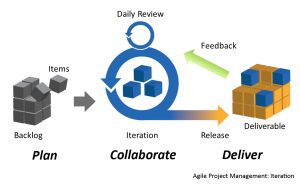 Project management may now be considered as one of the most popular and widely-practiced fields today. More organizations have become involved in handling projects while the number of software for project management continues to grow. Moreover, various project management methodologies have sprouted and among these is the Agile methodology.
Project management may now be considered as one of the most popular and widely-practiced fields today. More organizations have become involved in handling projects while the number of software for project management continues to grow. Moreover, various project management methodologies have sprouted and among these is the Agile methodology.
What is Agile Methodology?
Project managers may be familiar with it but here is additional information for those who want to know more. The Agile methodology uses the iterative approach to delivering output throughout the life cycle of a project. This means that the project is broken into stages which are called sprints and the team collaborates with the stakeholders.

There are basically four main values of Agile which are:
- Putting more importance on the use of software than on documentation
- Working hand-in-hand with customers over negotiating a contract
- Being more open to change than sticking to a plan
- Choosing individuals and interactions over processes and tools
Lessons learned this year about Agile Methodology
The Agile Manifesto helped make the methodology popular since it was published some 18 years ago. Now, it is very obvious that Agile is effective but not really perfect. Here are the lessons learned this year.
1. Agile should not be a reason not to plan
One of the main values of Agile is being more open to change than following a plan. This has made quite a number of organizations believe that they do not need a plan at all. But that is not true. Just like any other approach, planning is important and an essential part. Any project or endeavor that succeeds is due to a lot of planning and forecasting. How can a team change their plan of action if there is no plan to begin with? Teams and organizations need to remember that projects, especially software development, involve many decisions to make. In a nutshell, agile programs have projected dates and require specific results, with a given budget to work with.
2. Teams should not be sparing with dedicated team staffing and co-location
According to the Agile Manifesto, face-to-face communication is the most effective and efficient method of conveying information within a team. Moreover, it also says that developers and business people should be working together daily until the project is completed. This means that co-location is still effective. However, there are certain points that have to be satisfied in order for it to continue to work.

- The working space should be quiet and private and must encourage collaboration among the members. By saying quiet, it should give each member the personal and professional space they need to be effective in their work.
- Dedicated team staffing does not always mean having all the team members present in the room. This makes it possible for offshore or remote teams to continue to operate. However, project managers have to make sure that there should be a strong linkage between and among all members. There have to be times when a global meeting is held, whether physical or online, and everyone should be present. If the stakeholders opt for co-location, then, they should understand that the costs at the beginning will be higher. This is because of the travel expenses of members and the fact that part-time workers will now be working full-time.
- Working on projects using Agile is the trend and is seen as going to be forever.
3. Scrum and Agile are not the same
Many people think that Scrum and Agile are the same which is not correct. Unfortunately, in 2019, several groups were seen to have hired ‘Agile coaches’. They primarily taught about Scrum and the use of supporting tools which is not in accordance with the values of Agile. This is specifically in terms of ‘choosing individuals over processes and tools’. Though Scrum is effective and helps implement many Agile principles and values, it cannot sustain agility.
4. Leadership is important
The Agile Manifesto emphasized the importance of the team as the primary unit of delivery. It was always important to build projects that included motivated members. They also had to be given the support they needed and the right environment. However, leadership has been proven to be as important, especially in realizing the following points:
- Configuring the right team. In order for a team to be successful, they have to have the right members with the right skills set. Leaders have the ability to put members to a team where his skills are needed and remove those who belong to other projects.
- Bringing the team close to the stakeholders and partners and vice versa.
- Being there to help make decisions when needed. Leaders have to reliable and should be available when their team needs them. He should provide assistance and should be the glue that brings the team together.

Conclusion
Agile has been proven successful and organizations that use it will most likely succeed if they learn from these lessons. More importantly, teams should remember that regardless of the method they use, it is how the members use it and their skills that matter.
Leave A Comment